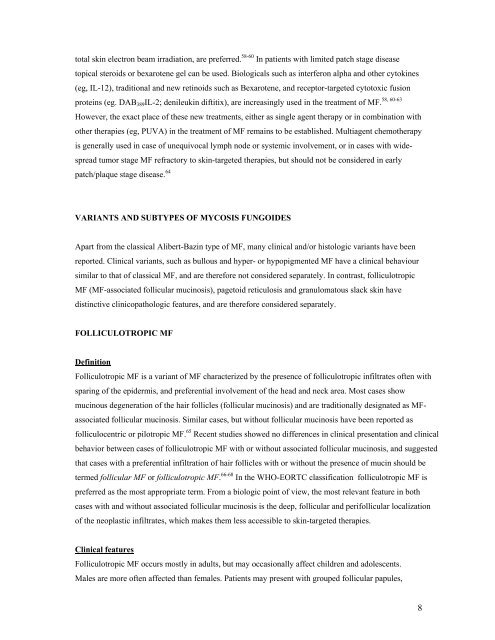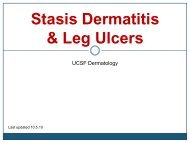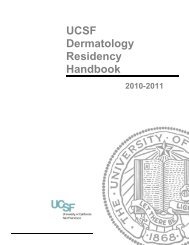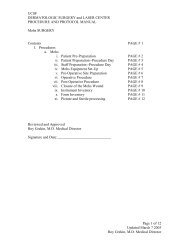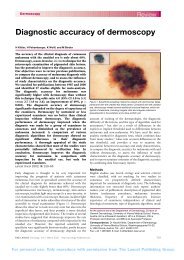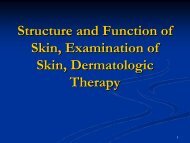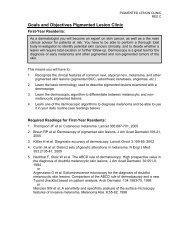who-eortc classification for cutaneous lymphomas - Dermatology
who-eortc classification for cutaneous lymphomas - Dermatology
who-eortc classification for cutaneous lymphomas - Dermatology
Create successful ePaper yourself
Turn your PDF publications into a flip-book with our unique Google optimized e-Paper software.
total skin electron beam irradiation, are preferred. 58-60 In patients with limited patch stage disease<br />
topical steroids or bexarotene gel can be used. Biologicals such as interferon alpha and other cytokines<br />
(eg, IL-12), traditional and new retinoids such as Bexarotene, and receptor-targeted cytotoxic fusion<br />
58, 60-63<br />
proteins (eg. DAB389IL-2; denileukin diftitix), are increasingly used in the treatment of MF.<br />
However, the exact place of these new treatments, either as single agent therapy or in combination with<br />
other therapies (eg, PUVA) in the treatment of MF remains to be established. Multiagent chemotherapy<br />
is generally used in case of unequivocal lymph node or systemic involvement, or in cases with wide-<br />
spread tumor stage MF refractory to skin-targeted therapies, but should not be considered in early<br />
patch/plaque stage disease. 64<br />
VARIANTS AND SUBTYPES OF MYCOSIS FUNGOIDES<br />
Apart from the classical Alibert-Bazin type of MF, many clinical and/or histologic variants have been<br />
reported. Clinical variants, such as bullous and hyper- or hypopigmented MF have a clinical behaviour<br />
similar to that of classical MF, and are there<strong>for</strong>e not considered separately. In contrast, folliculotropic<br />
MF (MF-associated follicular mucinosis), pagetoid reticulosis and granulomatous slack skin have<br />
distinctive clinicopathologic features, and are there<strong>for</strong>e considered separately.<br />
FOLLICULOTROPIC MF<br />
Definition<br />
Folliculotropic MF is a variant of MF characterized by the presence of folliculotropic infiltrates often with<br />
sparing of the epidermis, and preferential involvement of the head and neck area. Most cases show<br />
mucinous degeneration of the hair follicles (follicular mucinosis) and are traditionally designated as MFassociated<br />
follicular mucinosis. Similar cases, but without follicular mucinosis have been reported as<br />
folliculocentric or pilotropic MF. 65 Recent studies showed no differences in clinical presentation and clinical<br />
behavior between cases of folliculotropic MF with or without associated follicular mucinosis, and suggested<br />
that cases with a preferential infiltration of hair follicles with or without the presence of mucin should be<br />
termed follicular MF or folliculotropic MF. 66-68 In the WHO-EORTC <strong>classification</strong> folliculotropic MF is<br />
preferred as the most appropriate term. From a biologic point of view, the most relevant feature in both<br />
cases with and without associated follicular mucinosis is the deep, follicular and perifollicular localization<br />
of the neoplastic infiltrates, which makes them less accessible to skin-targeted therapies.<br />
Clinical features<br />
Folliculotropic MF occurs mostly in adults, but may occasionally affect children and adolescents.<br />
Males are more often affected than females. Patients may present with grouped follicular papules,<br />
8


